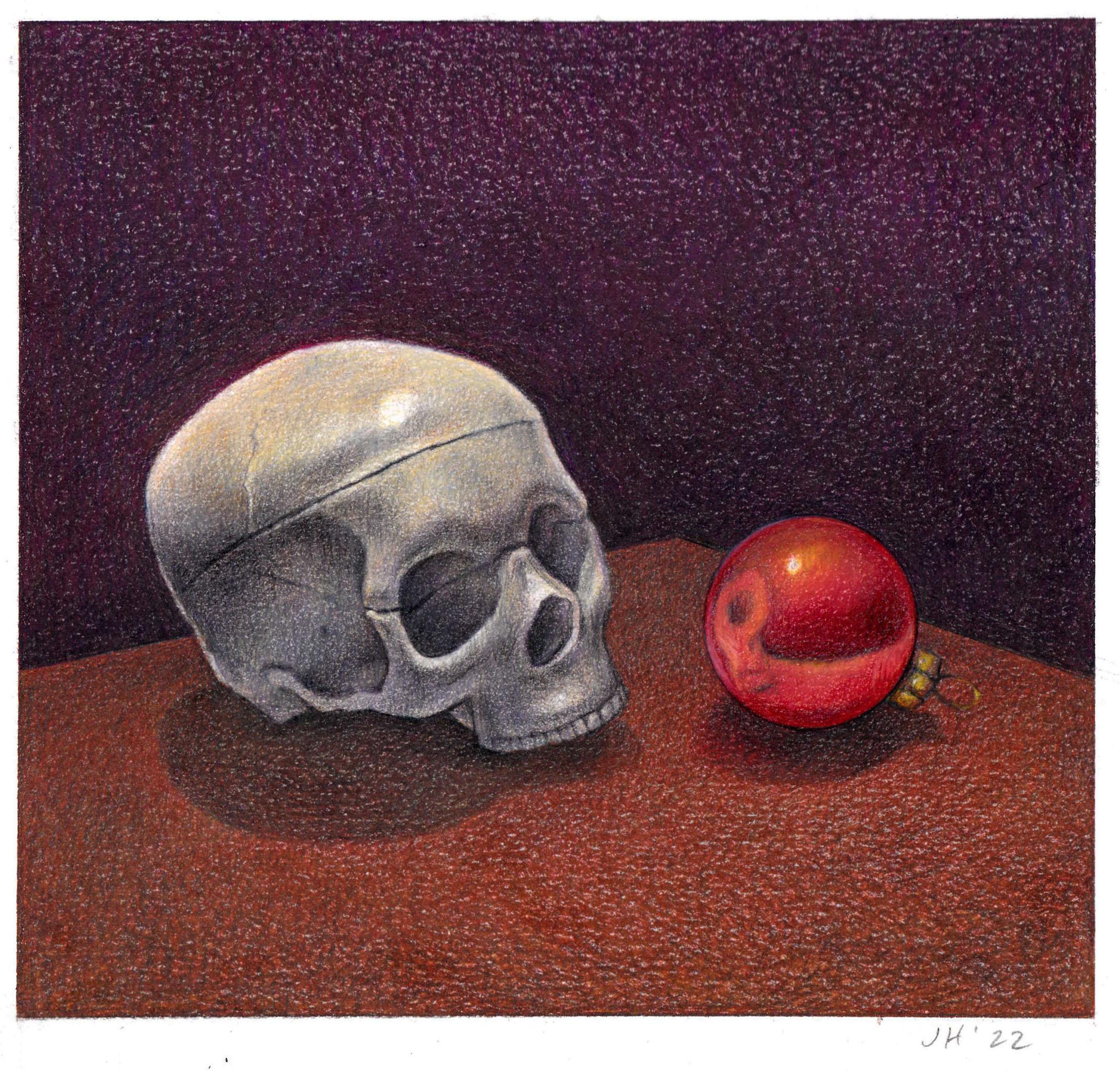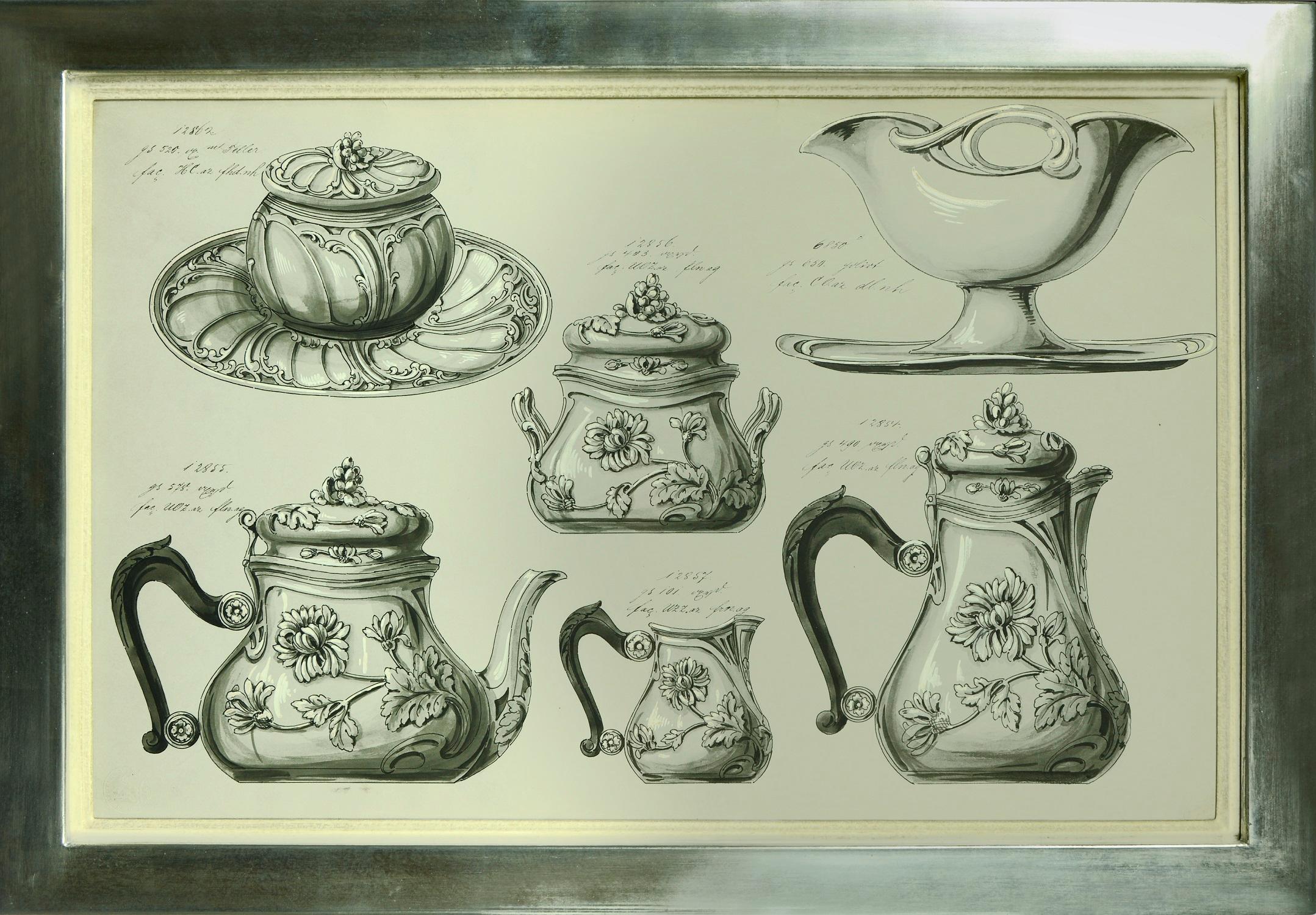Items Similar to Still life with fish bones, pencil and pencil sharpener
Want more images or videos?
Request additional images or videos from the seller
1 of 8
Manfred K. SchwitteckStill life with fish bones, pencil and pencil sharpener1992
1992
About the Item
Manfred K. Schwitteck (*1948), Still life with fish bones, pencil and pencil sharpener, 1992. watercolor over pencil on handmade paper, 31.5 x 45 cm (visible size), 47 x 61 cm (frame), signed in the center "m. k. schwitteck" and dated "25.8.[19]92", framed in passepartout under glass.
- very well preserved and attractively framed
- Die Ironie der Kunst -
About the artwork
Four remnants of consumed fish are arranged into a kind of fish shape. In the middle of this 'fish body' is a clip, a pencil sharpener and a pencil situated, above it lies a spring onion.
Manfred Schwittek creates here a still life, which has a self-reflexive dimension through the pencil and the pencil sharpener, since the picture was also drawn with the pencil. Yet the pencil is still sharpened and ready for new such creations, just as the onion could also still be prepared. The fish heads peeking out of the picture, on the other hand, are remnants, which, however, from the perspective of being artistically created, do not represent waste or leftovers, but are also something created. The bell is a humorous, as it were giggling accessory that draws attention to the contradiction between waste and art and at the same time seems to be amused by it.
GERMAN VERSION
Manfred K. Schwitteck (*1948), Stillleben mit Fischgräten, Bleistift und Anspitzer, 1992. Aquarell über Bleistift auf Büttenpapier, 31,5 x 45 cm (Sichtmaß), 47 x 61 cm (Rahmen), mittig mit „m. k. schwitteck“ signiert und auf den „25.8.[19]92“ datiert, im Passepartout unter Glas gerahmt.
- sehr gut erhalten und ansprechend gerahmt
- Die Ironie der Kunst -
zum Kunstwerk
Vier Überbleibsel verzehrter Fische sind zu einer Art Fischform angeordnet. Inmitten dieses ‚Fischkörpers‘ ist eine Schelle, ein Anspitzer und ein Bleistift situiert, darüber liegt eine Frühlingszwiebel.
Manfred Schwittek schafft hier ein Stillleben, das durch den Bleistift und den Anspitzer eine selbstreflexive Dimension aufweist, da das Bild auch mit dem Bleistift gezeichnet worden ist. Dabei ist der Bleistift noch gespitzt und zu neuen derartigen Kreationen bereit, so wie die Zwiebel ebenfalls noch zubereitet werden könnte. Die aus dem Bild herausblickenden Fischköpfe sind hingegen Überbleibsel, die unter der Perspektive des künstlerischen Geschaffen-Seins jedoch keinen Abfall oder Rest darstellen, sondern ebenfalls etwas Geschaffenes sind. Die Schelle ist ein humorvolles, gleichsam kicherndes Accessoire, das auf den Widerspruch zwischen Abfall und Kunst aufmerksam macht und sich zugleich darüber zu amüsieren scheint.
- Creator:Manfred K. Schwitteck (1948, German)
- Creation Year:1992
- Dimensions:Height: 18.51 in (47 cm)Width: 23.63 in (60 cm)Depth: 0.79 in (2 cm)
- Medium:
- Movement & Style:
- Period:
- Condition:
- Gallery Location:Berlin, DE
- Reference Number:1stDibs: LU2438212429272

About the Seller
5.0
Vetted Seller
These experienced sellers undergo a comprehensive evaluation by our team of in-house experts.
Established in 2014
1stDibs seller since 2023
7 sales on 1stDibs
Typical response time: 6 hours
- ShippingRetrieving quote...Ships From: Berlin, Germany
- Return PolicyA return for this item may be initiated within 14 days of delivery.
More From This SellerView All
- Still life with fish bones and champagne corks / - Behind still life -Located in Berlin, DEManfred K. Schwitteck (*1948), Still life with fish bones and champagne corks, 1992. watercolor over pencil on handmade paper, 31.5 x 45 cm (visible size), 47 x 61 cm (frame), signed...Category
1990s Surrealist Still-life Drawings and Watercolors
MaterialsWatercolor, Etching
- Study with Torso, Hands, and Umbrella - The characteristic of the inconspicuousLocated in Berlin, DEPaul Friedrich Meyerheim (1842 Berlin - 1915 ibid.). Sketch of a female torso with hands and an umbrella. Pencil on paper, 27.5 x 22.5 cm (visible size)...Category
1890s Realist Figurative Drawings and Watercolors
MaterialsPencil
- Plant Impression in Locarno - Floral Crescendo -Located in Berlin, DEAlexander Frenz (1861 Rheydt - 1941 Düsseldorf). Plant impression in Locarno. Gouache and watercolour. 35 x 23,5 cm (visible size), 49,5 x 38,5 cm (fra...Category
1890s Impressionist Landscape Drawings and Watercolors
MaterialsWatercolor
- Clay jug on a bench - The essence of the clay jar revealed by the sunlight -By Hans Richard von VolkmannLocated in Berlin, DEHans Richard von Volkmann (1860 Halle (Saale) - 1927 ibid.), Clay jug on a bench. Pencil and Watercolour on paper. 20 x 26,7 cm (visible size), 37 x 45 cm (frame), dated and monogrammed lower left "Februar 1890 - HR. V. V." - Minimally tanned. Framed behind glass in a passepartout. About the artwork Using the technique of his early youth - pencil and watercolour - Hans Richard von Volkmann depicts a still life. However, this is not a conventional indoor still life, but an open-air depiction, painted outdoors and not in the studio. It is therefore an open-air painting, characteristic of von Volkmann's oeuvre, which could have been painted in the Willingshausen colony of painters, where open-air painting was programmatically practised there and the artist stayed there that year. And indeed, this painting is a manifesto of open-air painting. Von Volkmann demonstrates that leaving the studio for the light of nature leads to an entirely new quality of art. To prove this, he uses the genre of still life, which can be described as the studio subject par excellence. Moreover, light plays an essential role in the classical still life. It is the real protagonist of the still life. And it is precisely this moment, essential to the still life, that von Volkmann exploits to demonstrate the potential of plein-air painting: He presents the objects as they appear in the sunlight. The date of February and the bare branches in the foreground make it clear that this is a clear winter day in bright sunlight. The delicate plant in the foreground casts a clearly defined shadow, as does the jug. However, the shadow is most pronounced on the jug itself: The underside of the handle appears almost black, making the top, and therefore the jug itself, shine all the more brightly. The shining of the objects in the sunlight is also visible on the bench. As complementary phenomena to the shadow zones, light edges can be seen on the boards of the seats and the upper foot of the bench shines entirely in the light. To achieve this intensity of light, von Volkmann activated the bright white of the painting ground. By depicting the objects in glistening sunlight, von Volkmann demonstrates that this quality of light is only to be found outdoors. And this light leads to a new way of looking at the objects themselves. The jug on the bench seems like an accidental arrangement, as if the artist had stumbled upon this unintentional still life and captured it with fascination. And in this fascination there is a moment of realisation that refers to the objects themselves. It is only when they shine brightly in the sunlight that their true nature is revealed. In this way, sunlight allows the objects to come into their own, so to speak. Sunlight, which is not present in the studio, gives the still life an entirely new dimension of reality, which is also reflected in the colours interwoven by the sunlight: The bench and the jug stand in a harmonious grey-pink contrast to the green of the implied meadow. The emphasis on the jug as the central subject of the picture also implies that the watercolour has not been completed. This non finito inscribes a processuality into the picture, making it clear that something processual has been depicted, the temporality of which has been made artistically permanent. This is why von Volkmann signed the painting and dated it to the month. About the Artist Von Volkmann made his first artistic attempts at the age of 14. He painted many watercolours of his home town of Halle. This laid the foundation for his later outdoor painting. In 1880 his autodidactic beginnings were professionalised with his admission to the Düsseldorf Art Academy. There he studied under Hugo Crola, Heinrich Lauenstein, Johann Peter Theodor Janssen and Eduard von Gebhardt until 1888. Von Volkmann then moved to the Karlsruhe Academy, where he was Gustav Schönleber's master pupil until 1892. In 1883 he came for the first time to Willingshausen, Germany's oldest painters' colony, at the suggestion of his student friend Adolf Lins...Category
1890s Naturalistic Still-life Drawings and Watercolors
MaterialsWatercolor
- Shady hollow way - Into the heart of the forest -By Hans DvoràkLocated in Berlin, DEHans Dvořák (19th century). Shady hollow way in a sunny forest. Watercolour and pen-and-ink drawing, 58.5 x 43 cm (visible size), 70 x 55.5 cm (frame), signed and dated "Hans Dvořák ...Category
1880s Realist Landscape Drawings and Watercolors
MaterialsWatercolor
- High Moorland Landscape in the fog - The world as a transcendent phenomenon -Located in Berlin, DECharles Edward Brittan Jr (1870 Plymouth - 1949). High moor landscape in the fog. Gouache, signed at lower left "Charles E. Brittan", 18 x 34.5 cm (passepartout), 45 x 62 cm (frame)....Category
Early 20th Century Realist Landscape Drawings and Watercolors
MaterialsWatercolor
You May Also Like
- Skull and Ornament - Vanitas, Still Life, Color Pencil Drawing, FramedBy John HrehovLocated in Chicago, ILDrawings of skulls are often called vanitas, which often contain collections of objects symbolic of the inevitability of death and the transience and vanity of earthly achievements and pleasures; it exhorts the viewer to consider mortality and to repent. This still life vanitas drawing is matted with a heavy white mat and framed in a bronze toned wooden frame measuring 15.75 x 16.25 inches. John Hrehov Skull and Ornament colored pencil on paper 7h x 8w in 17.78h x 20.32w cm JHR006 John Hrehov Education 1985 MFA-Painting, University of Illinois at Urbana-Champaign 1981 BFA-Painting, Cleveland Institute of Art, Cleveland, OH. Solo Exhibitions 2017 John Hrehov, Paintings and Drawings. Tom Thomas...Category
2010s Surrealist Still-life Drawings and Watercolors
MaterialsArchival Paper, Color Pencil
- Gun from ClueBy A.J. FriesLocated in Buffalo, NYAn original mixed media drawing by American artist A.J. Fries.Category
21st Century and Contemporary Realist Figurative Drawings and Watercolors
MaterialsGouache, Graphite, Paper
- Custom TextBy Charles BuckleyLocated in New York, NYCharles Buckley received an MFA from Hunter College a BFA in painting from California College of Arts in Oakland. Buckley’s progression paintings and drawings, often on multiple canv...Category
2010s Pop Art Figurative Drawings and Watercolors
MaterialsPaper, Gouache, Pencil
- Collection of Watercolour Designs for Silverware.Located in London, GB[ANON.] Collection of Watercolour Designs for Silverware. South Germany, [Late 19th century]. A series of 9 watercolours, each framed and glazed, ...Category
Late 19th Century Figurative Drawings and Watercolors
MaterialsPaper, Watercolor, Pencil
- UntitledBy Alexander RossLocated in Saint Louis, MOAlexander Ross Untitled, 2007 Watercolor, colored pencil, gouache and graphite on paper Framed Dimensions: 28 x 25.5 inches (71.1 x 64.8 cm) Image Dimensions: 23 x 22 inches (58.4 ...Category
Early 2000s Contemporary Still-life Drawings and Watercolors
MaterialsWatercolor, Gouache, Archival Paper, Color Pencil, Graphite
- Big Fruit Nude, colorful, imaginative nude with fruit on pastel on toned paperBy Stephen BassoLocated in Brooklyn, NY*ABOUT Stephen Basso Stephen Basso's highly original pastels and oil paintings are romantic, yet thought provoking fantasies. His whimsical works are alive with boundless imagina...Category
2010s Surrealist Figurative Drawings and Watercolors
MaterialsPastel, Archival Paper




